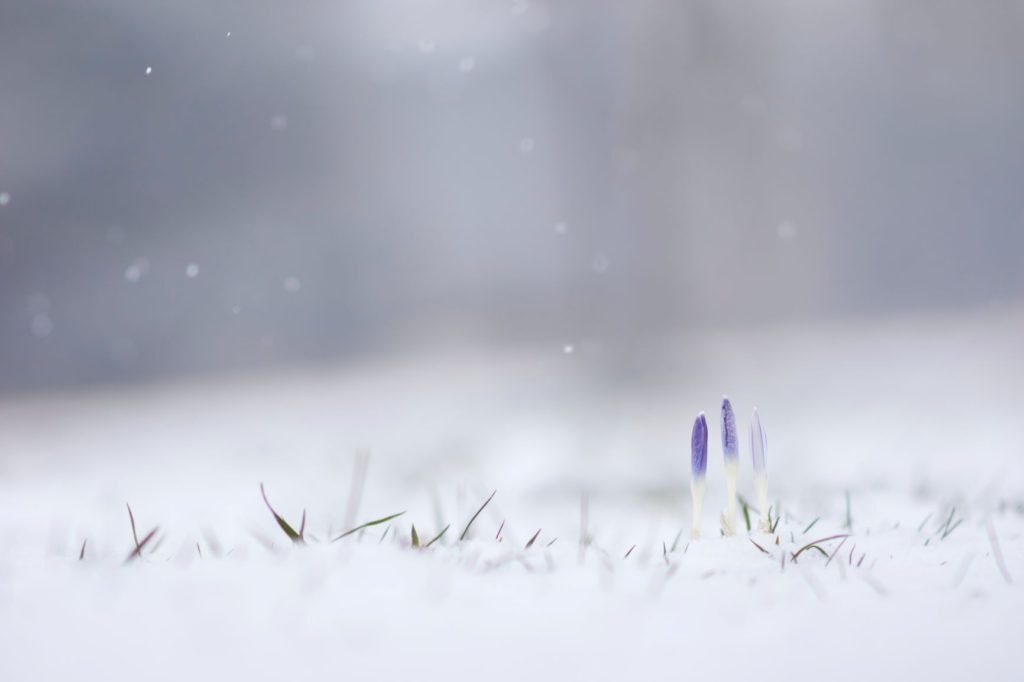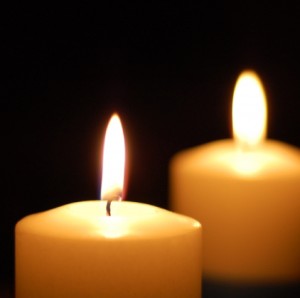I heard a lesser goldfinch sing his spring question and answer melody today. Waking up? he asks. Oh, do, he answers.
Crocuses, daffodils and tulips quicken underneath the snow.
Buds swell on bare trees sturdy as sculptures, though it will be many weeks till tender leaves emerge.
The feast of barely beginning is here!
Weeks of winter left, yes. Yet … Have you noticed the sun rising just a little earlier, shedding golden light on surfaces untouched for months by her rays? Have you noticed her just a little higher in the winter sky? Have you felt the lengthening days?
Earth, barely pregnant with new life, dances in snowy meadows and along forest trails, arrayed in festal white, silver, and the barest hint of spring green, holding her barely bulging belly.
Women walk riverbanks, gather new green willow branches and weave Brigid’s crosses to mark thresholds in this fresh year.
Melt, just a little, in the warmth of Brigid’s fire. Let go. Let yourself dream, dear child, of what could be. Dream, daughter, of what you want to create in the coming long summer days. Courageously dream into being the world you want to live in. And dream, Braveheart, of your heart’s companions in this work.
Bake bread. Make space. Speak true words at the right time. Bravely create the world you yearn for, one seed at a time. One furrow at a time. Row by row.
Set your holy intentions.
Tend your taproot. Feel your roots deep in the Mother wake up and slowly, so slowly, stretch and reach to touch your sisters all around you. Feel how everything you need is here. Feel your immense quiet power, slowly waking, held, supported, nourished by Earth—rich dirt feeds you, fresh cold snowmelt trickles down between your roots, warm sun limbers your branches, bright air infuses every leaf and needle. You have everything you need. Everything you need is here. You are perfectly placed. Be who you are. All will be well.
The Feast of Barely Beginning is here. Be here now, a creature of this glorious barely waking Earth. Be where you are, and come.
Let yourself be moved, just a little. Let yourself be warmed, just a little. Just a little. Let yourself be a peaceful slowly burgeoning miracle, waking, swelling, singing softly, rooting, growing. Just a little.
Just a little.
Just a little.
This poem is about Imbolc. Imbolc is one of eight Celtic celebrations rooted in Earth’s cycles – four solar festivals of solstices and equinoxes, plus four pastoral festivals: Imbolc in February, Beltane in May, Lughnassa (or Lammas) in August, and Samhain in November. These Earth-centric celebrations affirm the birth/death/rebirth cycle in which women especially are embedded by virtue of our menstruating bodies, and for which we have been shamed by patriarchal culture.
Celtic rites are an antidote to Earth-denigrating, patriarchal Christianity which is hostile to women and girls, and not all that kind to men.
At Imbolc (Candlemas, Brigid’s Day, Groundhog Day, the Feast of the Presentation), celebrated at the beginning of February, we begin to see the first stirrings of rebirth after the darkness of Winter Solstice and the longest night. Here in the Northern Hemisphere, days lengthen perceptibly. In Bend, today is an hour longer than it was on December 21st, and the sun is just a little higher in the winter sky. Bird behavior is just beginning to change, as the males begin to preen and sing and vie for female attention, and the females begin to consider their mating options. Buds on trees begin to swell in the growing daylight, although it will be weeks before leaves emerge. Bulbs begin to sprout in the dark dirt under the snow.
The energy of Imbolc feels like beginning. A gentle beginning, not raucous and full of fireworks, but slow, steady, almost imperceptible. Imbolc feels like the first little belly bulge of a new pregnancy. (Imbolc may derive from the Irish Gaelic word for “in the belly,” although the etymology is uncertain.)
Some Imbolc rituals have survived in Ireland for centuries and are rooted in pre-Christian history. Some are probably just invented because they help Earthlings ritualize the passage of time and ground them in Earth’s rhythms. February 1st begins the Feast of Brigid, also called Bride, one face of the Celtic triple goddess composed of maiden, mother, and crone, adopted by the Christian tradition as St. Brigid. Traditional Imbolc celebrations center on Brigid, an icon of holy change.
Imbolc celebrations in Ireland, and around the world for people who have adopted these Earth-honoring practices and made them their own, include some common elements:
- White, green, and silver in cloth and candles.
- Weaving Brigid’s crosses from local grasses, reeds, and willow branches, hung over doorways to mark thresholds.
- Deep cleaning and space clearing, in preparation for new life.
- Literal seeds: bake seeded bread or cookies or cake.
- Seeds of intention: Make a vision board for 2021. Choose your word of the year if you haven’t already. Let the gentle spaciousness of Imbolc feed your vision, and you may come up with something more whole and healing than what you would have on January 1.
- Sheep’s milk or wool: Imbolc in Ireland is when ewes begin to lactate in preparation for giving birth, so eat some ewe’s milk cheese. Tie off your Brigid’s cross with wool.
- Light candles. Sit by a fire. It is still winter, after all.
- Bird feathers, especially those of the swan, can be used on your cross or your altar.
- Snowdrops are the traditional flower of Imbolc, but any white flower will do, if snowdrops are in short supply.
Go easy with yourself. Let the gentle energy of just beginning permeate your February. Sit with what feels good to your barely burgeoning roots and shoots. Brigid won’t mind if you weave her cross next week, or make a vision board later in the month. Be gentle. Watch for rebirth, yours and the Earth’s, barely beginning.
Photo by Wolfgang Hasselmann on Unsplash


